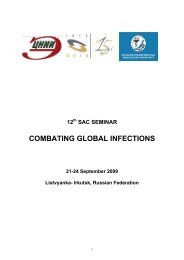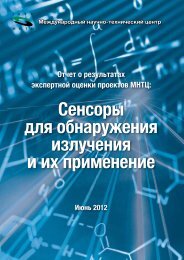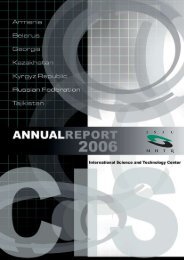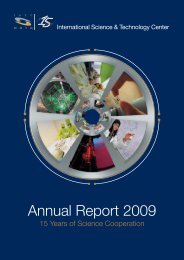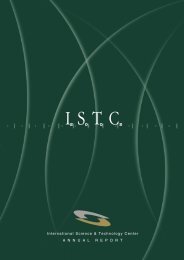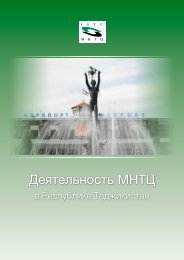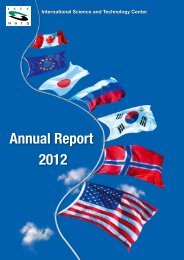Aerospace Research - ISTC Funded Projects 1994-2009
Aerospace Research - ISTC Funded Projects 1994-2009
Aerospace Research - ISTC Funded Projects 1994-2009
You also want an ePaper? Increase the reach of your titles
YUMPU automatically turns print PDFs into web optimized ePapers that Google loves.
An integrated analysis was made by separate<br />
directions:<br />
– ascertaining a rational aerodynamic airframe<br />
configuration, including rational wingplan,<br />
shapes of airfoil sections and other airplane<br />
components, such as units of control and trim,<br />
with the use of uptoshape numerical methods<br />
of aerodynamics;<br />
– development and manufacturing of aerodynamic<br />
models as well as a drained wing<br />
compartment, ejector suction system, air<br />
intake simulator and nozzle for experimental<br />
investigations of powerplant/airframe<br />
interference;<br />
– experimental tests in TsAGI wind tunnels<br />
(T102, T106) aimed at refining takeoff–<br />
landing aerodynamic characteristics and<br />
determining their achievable level more<br />
precisely (Fig. 7);<br />
– studies of the interference effect of the<br />
propulsion unit mounted on the upper wing<br />
surface, near the trailing edge, as applied to<br />
airplanes with turbojet engine T129;<br />
– formulation of a rational airframe structural<br />
concept on the basis of finite element methods,<br />
analysis of stressedstrained state, stiffness,<br />
and weight characteristics;<br />
– exploration of possibilities to use the<br />
structure elasticity and mass distribution for<br />
enhancing the aerodynamic characteristics of<br />
the airplane, its lift qualities, reducing the<br />
aeroelastic aerodynamic center shift,<br />
increasing control effectiveness and critical<br />
flutter speed;<br />
– formulation of recommendations on passive<br />
and active reduction of wing bending moments<br />
and increase in the load ratio;<br />
– generation of controls with due regard for<br />
their multifunctional application, selection of a<br />
rational structure and parameters of the flybywirecontrol<br />
system and active control<br />
systems with consideration for the<br />
requirements providing the comfort of<br />
passengers and crew;<br />
Enhancement of Flight Performance, Economy and Efficiency<br />
– analysis of the agreement between the<br />
requirements of aeroelstic stability of the<br />
airplane and the automatic flight control in all<br />
regimes;<br />
– experimental studies of stability and<br />
controllability characteristics using piloted<br />
simulators of TsAGI;<br />
– configurational studies related to<br />
accommodation of passengers and cargo to<br />
verify the possibility of meeting the<br />
airworthiness standards; and<br />
– comparative analysis of fuel and cost<br />
efficiency of flyingwing and conventional<br />
airplanes similar in their purposes.<br />
Obtained Results<br />
The major Project result is generation of<br />
technologies that enable designing of fullscale<br />
FW airplanes with a low technical risk.<br />
The comparison with a conventional<br />
configuration has revealed that the FW design<br />
offered the following advantages:<br />
Takeoff weight 13,4% lower<br />
Operating empty weight 6,4% lower<br />
Engine thrust 12% lower<br />
L/D ratio 19% higher<br />
Fuel consumption per flight 24% lower<br />
DOC 7%–9% lower (depending on fuel price)<br />
Fig. 7: Flying Wing model<br />
in TsAGI wind-tunnel<br />
31



